Dec 25, 2024
Mind Reset Volume 3
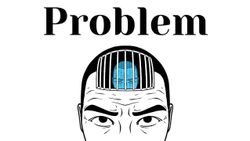
It’s tough to sit in a room with all the windows and doors shut, trying to imagine how sunlight will seep in and make you feel better. But when you open the windows and doors, the light naturally floods in, and you’ll see the sun. Similarly, instead of overthinking your abilities, if you remove all the limiting beliefs within you, there’s no need to overanalyze. Truth will unfold and express itself in each moment. But one thing is clear: if we hold on to our limitations, we won't be able to see the sun anytime soon.
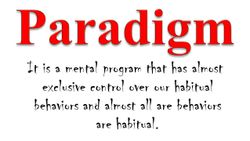
B
2
A paradigm is a mental program that holds us in its grip. The results we see in our lives today are more influenced by this paradigm than by our desires. Our lives are essentially a reflection of our daily habits. We often overlook the significance of our everyday actions—brushing our teeth, bathing, eating, drinking, and dressing—all of these form part of our habitual system.
3
Similarly, we have a habit of thinking in a certain way, a way that's not entirely our own but is learned from the society around us in the name of worldly wisdom. Throughout the day, we act less like ourselves and more like the world and society around us. If we change our behavior, our life will change. If not, we’ll end up living the same old, tired life. What prevents this change from happening is the paradigm, which controls our behavior through our habits. We all know that changing habits isn't easy. The methods are simple, but not easy.

C
4
A part of the paradigm is also genetic, which is why we resemble our parents and grandparents. Their thoughts are stored within our minds as memories. On the other hand, the environment plays a significant role in shaping the paradigm as well. Children under the age of 7 don't have the ability to think or understand fully. Their conscious minds are still developing, and their subconscious mind is wide open, absorbing everything around them. This period can be considered a hypnotic stage, where everything happening around the child—news, TV, language, laughter, jokes, arguments—goes directly into their subconscious mind, since the mind at this stage cannot reject anything; it simply accepts it all.
5
Whether true or false, good or bad, once a thought enters the subconscious, it becomes the child’s truth and reality. Since children at this age can't fully understand the reasoning behind things, they imitate their parents. If the parents are angry, the child may not understand why but will think, "If my parents are angry, then I am angry too." Similarly, the child will mirror whatever happens in the household. If everything is positive, this paradigm can become a source of strength; if not, it can enslave the mind for life. Without the light of knowledge, there will be no difference between a 7-year-old child and a 70-year-old adult.
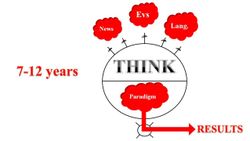
D
6
Between the ages of 7 and 12, the power of thinking and understanding begins to develop. During this time, children start asking questions like, "Why is the sky blue?" "Why is water wet?" "Why is chili spicy?" This is when the conscious mind starts to take shape. The senses were already there, but now the ability to understand is coming into play. The child begins to think and ask questions. This marks the end of the hypnotic stage. The conscious mind acts as a gatekeeper, so any information that enters the subconscious mind is now examined and questioned. If it makes sense, it’s accepted; otherwise, it’s rejected.
7
This is when the child begins to form a sense of their own identity and personality. It’s a crucial period, as it’s important to teach the child how to think properly. Everything in life comes at a price—whether it's time, effort, or money. The conscious mind not only controls our senses but also holds the key to the treasure of our beautiful life. In addition to the five senses, the conscious mind also has six higher mental faculties or superpowers, which we will explore in detail in the next video. These faculties must be developed through practice. The more you develop them, the more you’ll be able to create your own reality, rather than having it dictated by the outside world.
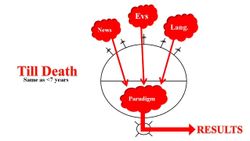
E
8
Today, the same child is now 25, 30, 35, or 40 years old. He knows how to live, how to write, but he doesn’t know how to think. He hears something here and expresses it there, sparking a fire in one place and spreading it elsewhere. Who has time to think and understand? The gatekeeper, the conscious mind, has become a joke—it lets everything in without questioning whether it’s true or not.
9
Look closely at the difference between a 7-year-old and today’s grown adult: both don’t think. The child doesn’t think because he lacks the ability to, but why doesn’t the adult think? Because, in many ways, he’s still a child; he hasn’t learned how to think. Thinking is an art that can be learned, just like learning to code or a new language. Yet, there’s no subject called "thinking" in our education system. If thinking classes existed, students would leave school equipped to thrive in life instead of feeling stuck. If you don’t think, the paradigm will think for you, and you will be controlled by it for the rest of your life. The subconscious mind is the action center, and that’s where the paradigm resides and thrives.
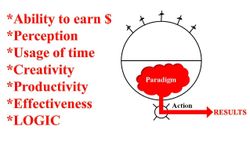
F
10
How does the paradigm control our life? A program called the paradigm controls the way we perceive the world, all while remaining invisible. It shapes our perception. Why does one person see problems while another sees opportunities? It's because of the paradigm. How we use our time isn’t really up to us—it’s determined by the paradigm. The paradigm controls our creativity. Whether a child is fair or dark, from one side of the world or another, whether they’re a boy or a girl, they are 100% born creative.
11
Creativity evolves over time, but the paradigm stifles that development. Our productivity and effectiveness are also governed by the paradigm. Logic, too, is influenced by the paradigm. So many dreams have been sacrificed to logic. The paradigm controls your logic. You cannot fully live your life if you keep dismissing your dreams as illogical. And last but not least, the paradigm controls how much money you can earn. In the end, the paradigm runs what you call your life, all without ever stepping into the spotlight.

G
12
The conscious mind holds the highest quality and superior knowledge to change the world, but it isn’t the action center. The subconscious mind is the action center, yet it carries a negative paradigm that leads to inferior results. Since the subconscious mind holds 97% of the mind’s power, the conscious mind cannot force it to move, no matter how hard we try. As a result, people don’t do what they should do, and they end up doing what they shouldn’t. We all know what could improve our lives, but despite putting in all our willpower, we fail to achieve our goals. We struggle endlessly, lose, and eventually give up. What remains is confusion, nothing more. The real problem is not understanding paradigms. The real issue is not understanding the mind. Ignorance is our true problem.
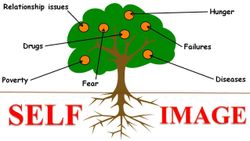
H
13
In our society, we don't actually have problems like drug addiction, alcohol abuse, smoking, bad relationships, pornography, failure, poverty, hunger, disease, or unemployment. (30 second pause) Wait, did I say something wrong? If a fruit turns out bad, you wouldn’t start spraying chemicals on it; instead, you'd check the quality of the seed and the nutrition it’s been given. It's the root, not the fruit, that’s the issue here. Drugs, alcohol, smoking, porn, bad relationships, failure, hunger—these are all fruits. The root cause of these issues is the seed, which is known as self-image. Paradigm is a huge program that contains many smaller programs, and one of them is self-image—your own mental picture of yourself. We don’t think in words, we think in pictures.
14
The process of forming a self-image is very similar to how a paradigm forms. Each of us has created an image based on past successes and failures. This self-image then directs our mind in a way that aligns with it, meaning your self-image becomes your reality, not necessarily what you want it to be. If your self-image is built on past failures, you'll act in a way that even when opportunities arise, you won’t be able to take advantage of them, leading you to fail again. On the other hand, if your self-image is based on past successes, it will be easier to seize opportunities and maintain a winning mindset. In both cases, it’s the self-image that sets the boundaries, not you.
15
There's a fantastic book called Psycho-Cybernetics by Maxwell Maltz, which revolutionized the field of personal development with his discovery of self-image. Maxwell Maltz was a plastic surgeon. After performing surgery, his patients often gained confidence—shy people started speaking more openly, angry individuals became lighter and happier. Success is not the best teacher; failure teaches us more. Maltz experienced this firsthand. Some of his patients didn’t feel any change even after successful plastic surgery. Despite clear differences in their before and after photos, they claimed they didn’t feel anything had changed. This is where the concept of self-image was uncovered. There's another inner image of yourself, one that many are unaware of, and its existence is just as real as your outer self. This self-image controls you like an invisible hand. The problem isn’t the drugs, alcohol, poverty, or anything else—it’s the negative self-image. A negative self-image is the real problem, not you.

I
16
Let's dive deeper into understanding self-image. We’ve all probably seen a chained elephant at some point. Have you ever wondered how such a powerful creature can be controlled by a small man with just a chain? The answer lies in the elephant’s childhood. When the elephant was small, it was chained. The baby elephant tried desperately to break free, but it couldn't, and in the process, it hurt itself. At that time, it didn’t have enough strength to break the chain. Day after day, it tried and failed, and eventually, the elephant gave up trying.
17
As the elephant grew stronger, more powerful, and capable of breaking the chains, it still remained trapped. Why? Because the image of its struggle as a baby remained in its mind. It didn’t know its true strength. All it knew was that the chains were unbreakable, and it believed its destiny was to be trapped. Despite having the power to break free, the elephant remained in chains because of its limited self-image.
18
This is exactly what happens to us. We all have immense potential and talents, but we’re often not free to reach them. The problem lies in our negative self-image. Whatever we saw and experienced in our childhood, we accepted as truth, without realizing the bigger truth of who we truly are.
19
The truth is this: we are not just physical beings; we are spiritual beings with the power of the mind, experiencing physical reality. Once we understand this, we can break free from the chains of negative self-image and tap into our true potential.
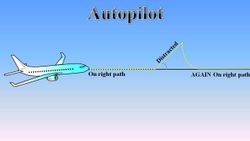
J
20
Let's dive deeper into how self-image is running our lives. Have you ever seen an airplane? It has a program called autopilot installed in it. The pilot is only needed at the beginning and end of the journey. For the rest of the time, the autopilot takes over and flies the plane. The entire route is pre-programmed into the autopilot system. If the plane is diverted off course due to bad weather, the autopilot detects this and automatically brings the plane back on the right path. Every time the plane goes astray, the autopilot corrects it and brings it back to the intended route.
21
Now, what does autopilot have to do with self-image? Well, self-image works like our personal autopilot. It is installed in each of us and governs how we operate in life. No matter how much effort we put in, we can never surpass the limits set by our self-image. It is impossible to "conquer" our self-image; it can only be updated. Just like an airplane cannot override its autopilot, we cannot simply override our self-image. We can only change it, update it, and evolve it to align with the life we want to create. The limits of our self-image set the course for our actions, and like the autopilot, it will constantly guide us back to the reality we believe is true about ourselves.
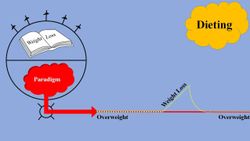
K
22
The problem of obesity is not just about the weight, but the self-image that drives it. Self-image is like the autopilot for our behavior, and it works relentlessly to keep us where we are, often reinforcing unhealthy patterns. Take the example of someone who is overweight and decides to lose weight. They create a diet plan, gather all the knowledge, and start following it. Initially, the weight drops, and they may feel good about it. However, the self-image of being overweight is still deeply ingrained in the subconscious mind, which governs their actions.
23
When the person starts seeing the weight drop, their subconscious mind detects the deviation from the familiar "overweight" self-image. It triggers a "red alert," and the autopilot kicks in, unconsciously creating situations where the person returns to their old habits. Maybe it’s a social event, a friend's wedding, or some other circumstance that makes them feel the need to eat more or act in ways that undo their progress. The weight comes back, and they’re back to square one, reinforcing the belief that they cannot sustain weight loss.
24
This cycle continues because the self-image hasn't been updated. The problem isn’t the diet plan itself; it’s the subconscious self-image that is misaligned with the desired outcome. Unless the self-image is changed, any effort will only lead to temporary results. Real, lasting change comes from updating the self-image first. Once that shift happens, the behavior and results will follow, leading to permanent change. So, don’t look for shortcuts or temporary fixes. The key to achieving lasting change is to update your self-image and let that guide you to the life you desire.

L
25
This example of the child struggling with their marks highlights how self-image plays a crucial role in shaping behavior and outcomes. When the child scores poorly and faces punishment, such as being grounded and restricted from playing, the immediate reaction is an attempt to force improvement through external pressure. This leads to a temporary change: the child studies harder and eventually scores well, and the restrictions are lifted. However, the real issue lies in the child's self-image, which remains unchanged.
26
When the child experiences success (good marks), the self-image autopilot kicks in and notices the deviation from the "low marks" self-image. The autopilot triggers a shift in behavior—allowing the child to return to their usual routine of playing and not studying as much, thinking that they have "earned" their freedom. Eventually, this leads back to poor marks, and the cycle repeats: low marks → scolding → hard study → good marks → freedom → back to old habits → poor marks.
27
The real issue is not the child's lack of effort or understanding of studying, but rather their perception of it. The child might not see the value in studying or might be motivated by other interests. Punishing the child for poor marks and imposing restrictions doesn't address the root cause, which is their self-image and attitude toward learning.
28
To break this cycle, the self-image needs to be updated. The child must develop a new perception of themselves as a capable student who values learning and sees the benefits of studying. This shift in self-image will lead to a genuine change in behavior that isn’t driven by external force or punishment but by an internal understanding of the value and importance of learning.
29
In the long term, updating the self-image is the key to achieving lasting change and breaking the cycle of short-term results. By addressing the root cause of the behavior (the self-image), the child can achieve permanent transformation, not just temporary success.
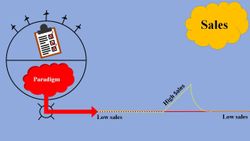
M
30
This example of the salesperson provides a clear illustration of how deeply self-image influences our ability to achieve beyond our perceived limits. The salesperson, regardless of the environment, had a self-image that set his financial boundary at $5000 per year. No matter how hard he worked, whether in a poor area or a rich area, he would always hit that same ceiling.
31
When placed in a rich area, where the opportunity for higher sales existed, he would reach the $5000 mark quickly and then unconsciously sabotage himself by becoming ill, halting his progress. His self-image, locked at $5000, triggered an autopilot response whenever he tried to exceed it, creating situations that forced him back to his comfort zone.
32
This phenomenon is a classic example of how our subconscious mind, influenced by the self-image, resists any attempt to surpass the limits we’ve unknowingly set for ourselves. The self-image acts like a protective mechanism, ensuring that we don't exceed what we've internalized as possible or deserved.
33
Just like the airplane's autopilot, which guides the plane along a predetermined path, the self-image functions to keep us aligned with the boundaries we've set in our own minds. The issue isn’t the external circumstances or the salesperson’s work ethic but the internal perception of what is achievable.
34
To experience permanent growth, whether in sales, wealth, or any other area, the self-image must be updated. If the salesperson’s self-image could be expanded to embrace the belief that he is capable of making higher sales, he would break through the $5000 limit and continue to thrive without self-sabotage.
35
This is why forcing change or relying on willpower alone is not enough. Real, lasting change happens when the self-image is consciously and intentionally updated, allowing us to embrace greater opportunities and push past our boundaries.

N
36
This comparison of the two individuals illustrates the immense power that our self-image and choices hold over our lives and circumstances. The first man’s choice to worry, coupled with his belief that death was imminent, led to his tragic end. Despite the physical conditions not supporting the conclusion that he would die from the cold, his mind had already made a decision, and his self-image and belief system aligned with that fate. This reinforces the idea that our thoughts and perceptions shape our reality more than the actual external circumstances.
37
On the other hand, Roger Bannister’s choice to ignore the so-called "impossible" and bet on himself transformed not only his life but also the lives of countless others. His belief in his potential and his self-image as someone who could break the 4-minute mile barrier made the impossible possible. As soon as he did it, others began to believe it was possible for them too, and the once-unbelievable became a standard achievement. This is a powerful demonstration of how changing our self-image and beliefs can literally rewrite the rules of what’s possible.
38
These stories show that self-image is not just a reflection of how we see ourselves but also the lens through which we experience and interpret the world. It determines the choices we make, the risks we take, and the limits we place on our lives. Our self-image shapes our reality, and by updating our self-image, we can transform our circumstances.
39
It’s a game of choices, and each choice is powered by the self-image we carry. If we choose to view ourselves as capable of more, of greatness, or of success, our reality will eventually reflect that. The power lies in how we choose to see ourselves—the image we hold of ourselves will dictate our experiences and outcomes. So, in essence, updating and consciously crafting a positive and empowering self-image is the key to altering our reality and circumstances.

O
40
This example demonstrates the self-dooming cycle where the individual’s focus on debt perpetuates the very thing they want to escape. The way we perceive our circumstances plays a huge role in shaping the reality we experience. When we focus on the lack—like debt—it gets embedded in the subconscious mind, and this then becomes the self-image we carry. That self-image influences our thoughts, actions, and decisions, all of which work to keep us in the cycle of debt.
41
The conscious mind processes external stimuli, such as seeing the debt and the empty bank account, but if this information is passed onto the subconscious mind with the belief that “I am in debt” or “I am poor,” it becomes a part of your self-image. Once your subconscious mind accepts this belief, it controls your actions—leading you to make decisions that may not be aligned with getting out of debt. Instead, your choices and behaviors may be influenced by fear or helplessness, increasing your financial strain.
42
This is a vicious cycle because the focus on debt leads to more financial problems, and until you shift your mindset and update your self-image, you will continue to experience this pattern. The first step in breaking this cycle is changing your perception and belief system—your self-image. Instead of identifying with being in debt, you must see yourself as someone who can handle and overcome financial challenges.
43
As you update your self-image, new ideas and opportunities will start to surface. Shifting your focus from the problem (debt) to the solution (earning money, creating opportunities, or improving your financial situation) will enable you to break the cycle. Once you begin thinking in a way that aligns with abundance and possibilities, the actions you take will naturally move you toward financial freedom.
44
In summary, the key is to update your self-image and shift your focus. Your mindset will ultimately determine the actions that lead to either the continuation of the problem or the creation of a solution.
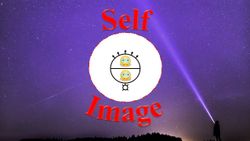
P
45
The self-image is like the internal blueprint of your life. It defines your sense of self-worth, your capabilities, and the boundaries of what you believe is possible for you. It’s powerful because it operates like an autopilot—driving your thoughts, decisions, and actions without you even realizing it. As long as your self-image remains unchanged, you'll continue to live within the limits it sets for you.
46
However, the good news is that while you can’t “win” against your self-image, you can update it to match the reality you want to create. This is where transformation happens. By consciously challenging and shifting the beliefs, thoughts, and perceptions that make up your self-image, you unlock new possibilities for yourself.
47
For example, if your self-image is that of someone who is always struggling financially, no matter what efforts you put in, you’ll find yourself attracting more struggles. But if you update your self-image to someone who is abundant, resourceful, and open to financial opportunities, your actions and decisions will align with this new self-image, and you’ll naturally begin to attract circumstances that reflect it.
48
Updating your self-image means embracing new beliefs, challenging old patterns, and reprogramming your subconscious mind. The more you align your thoughts, actions, and emotions with this updated image of yourself, the more you’ll see tangible changes in your life. In short, you can’t break your self-image—but you can reshape it to create the life you desire.
Summary
1. Self-Image as Autopilot:
*Your self-image acts like an autopilot, guiding your thoughts, behaviors, and actions.
*It is shaped by past experiences, beliefs, and perceptions and sets boundaries on what you believe is possible for you.
*Self-image cannot be conquered but can be updated for positive change.
2. Limitations of Self-Image:
*You cannot go beyond the limits of your current self-image.
*Any effort to exceed those limits will be counteracted by the subconscious mind, which will bring you back to your comfort zone.
*To achieve lasting change, you must update your self-image to match the success or outcome you want.
3) Reprogramming Your Subconscious:
*Your actions and results are influenced by the self-image you hold in your subconscious.
*Negative patterns or self-doubt reinforce the cycle of failure or limitations.
*Changing your beliefs and updating your self-image leads to different actions and better results.
4) The Power of Choice and Beliefs:
*Your choices and beliefs shape your reality. What you think, feel, and believe influences the results you create.
*To break out of a vicious cycle (e.g., debt, failure), you must shift your thinking and align it with your desired outcome.
*By updating your self-image, you allow new opportunities and solutions to emerge that align with your true potential.
5) Transformation Through Self-Image Update:
*Permanent changes come from a shift in self-image, not from temporary fixes or forceful efforts.
*When you align your self-image with your desired outcome, you create lasting, positive changes in your life.
By undefined
33 notes ・ 25 views
English
Proficient